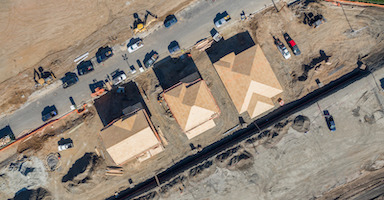14 Jan4 Ways to Use Compost Filter Sock
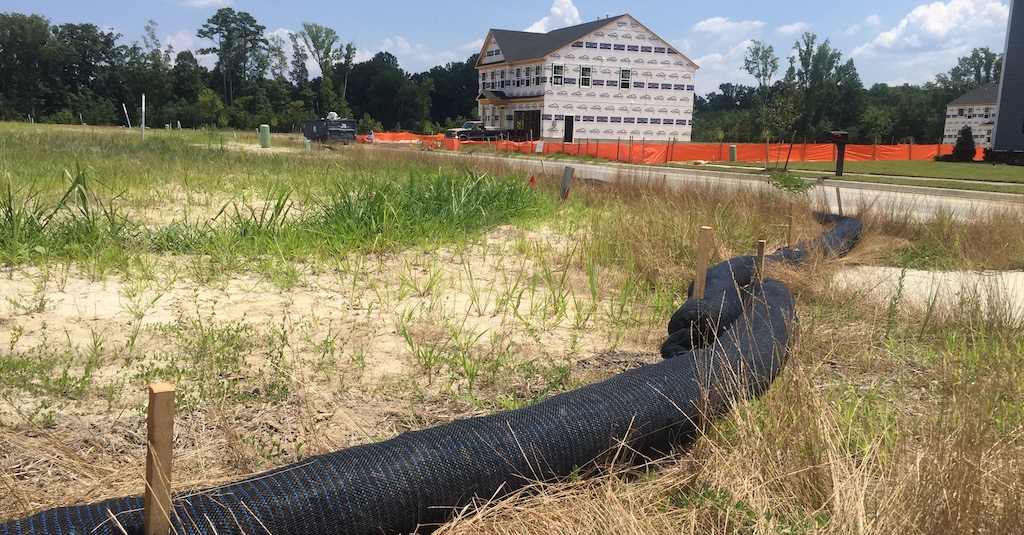
Silt Sock controls runoff and erosion on construction projects
Compost Filter Silt Sock is an erosion control wattle that is filled with a wood matrix and wrapped in a polypropylene photodegradable mesh.
The size of the wattle varies by manufacturer. Most products range from 8-inches to 24-inches in diameter and 10-feet to 200-feet in length.
Although manufacturers vary the fill, net and size, all Compost Filter Silt Socks are designed for the same purpose: slow the velocity of water to capture sediment laden runoff and prevent erosion.
What’s the problem with runoff?
Runoff runs over surface areas and collects pollutants like chemicals, pesticides, sediment and waste. When runoff flows into creeks, rivers and water bodies those pollutants cause irreparable damage to the ecosystem.
Contractors and construction owners have an obligation to control stormwater discharge from construction activity.
The United States Environmental Protection Agency (EPA) has a program called the National Pollutant Discharge Elimination System (NPDES) that regulates stormwater pollution by monitoring discharge sources. The EPA generally requires a permit for construction activity that disturbs more than an acre of land. These permits may be issued by the EPA or a state’s environmental agency. States and municipalities also have their own stormwater management programs. It’s important to understand how federal, state and local programs will affect your permits and plans. You can explore resources for some Mid-Atlantic states here:
Choosing the right products is the key to managing runoff. A multi-purpose product that addresses all of the discharge sources and sensitive points can result in real success and cost-savings.
Compost Filter Sock Applications
We recommend Compost Filter Sock for the four following applications:
- Perimeter Control
- Inlet Protection
- Check Dam
- Slope Interruption
It is important to note that Silt Sock won’t work for all four of these applications on every construction project. Additionally, it’s very important to pick a size that is suitable for the site application. We always suggest consulting site plans, project specifications and engineers before purchasing any erosion control product.
Perimeter Control
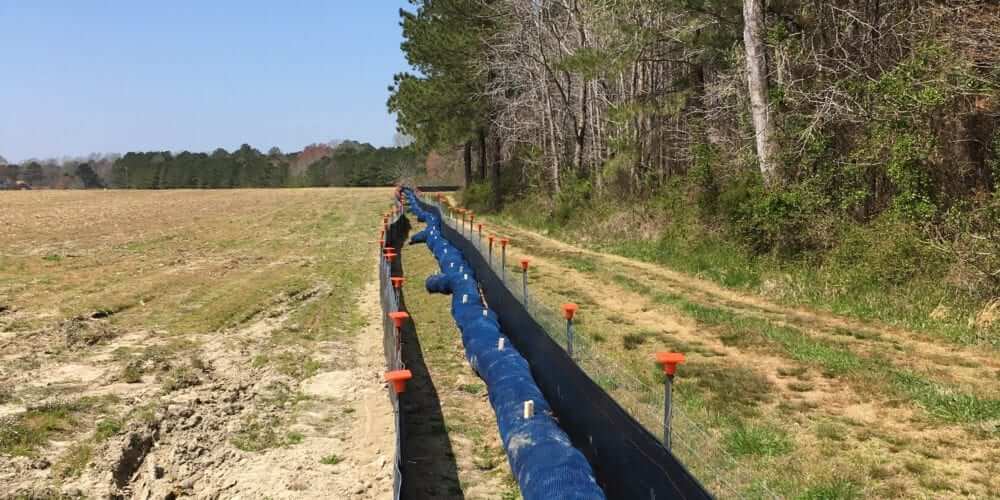
Silt Fence is the most specified sediment control product on construction sites. The temporary fence filters runoff, holds back sediment and establishes perimeter protection. On many sites, Silt Fence is a perfect and affordable solution for sediment control.
However, you need to dig a trench in order to properly install Silt Fence. The easiest way to dig a trench is with a trencher or mini-excavator. Trenching requires equipment, an equipment operator and room to operate.
Some construction sites, however, need temporary erosion control installed through trees, over asphalt or next to sidewalks. Urban sites and existing construction developments have limited space and ground conditions that are not ideal for trenching. This is when we suggest substituting Compost Filter Silt Sock for Silt Fence.
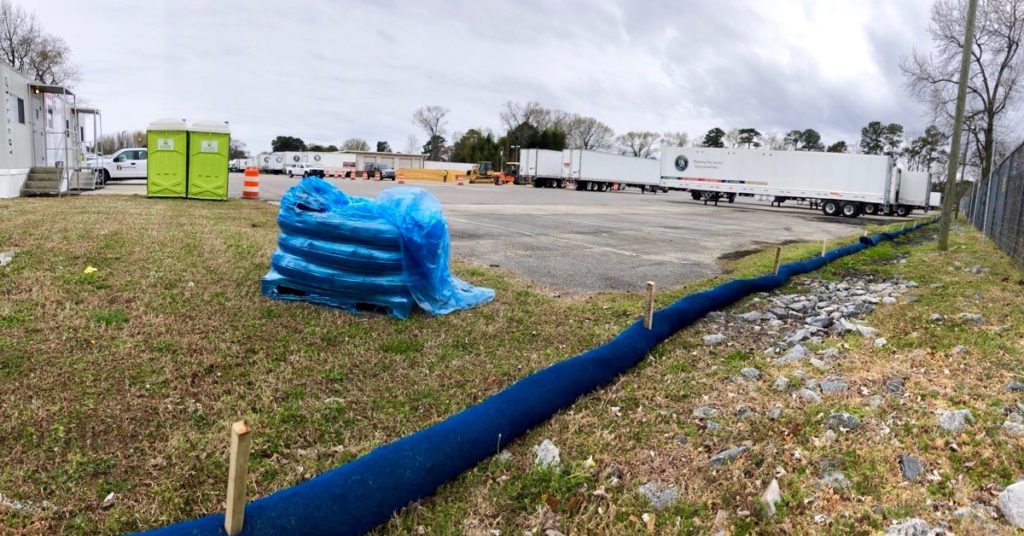
For example, this warehouse project in Chesapeake, Virginia, needed perimeter control near asphalt, rock and narrow spaces. We suggested the contractor install a continuous run of Compost Filter Sock in lieu of Silt Fence in order to avoid trenching.
It’s important to note, however, that some construction equipment is needed to handle this material.
Most pallets of Compost Filter Sock weigh between 1800-2000 pounds. A skid steer with pallet attachments typically works great for loading, unloading and installation. Installation will vary depending on the site conditions.
The contractor on the warehouse project, for example, installed the continuous pallets using a skid steer while a laborer unrolled the filter sock. In hard to reach areas, they cut the pallet of sock down to size and laid it in place. Wood fence posts were driven through the Compost Filter Silt Sock to secure it to the ground.
Inlet Protection
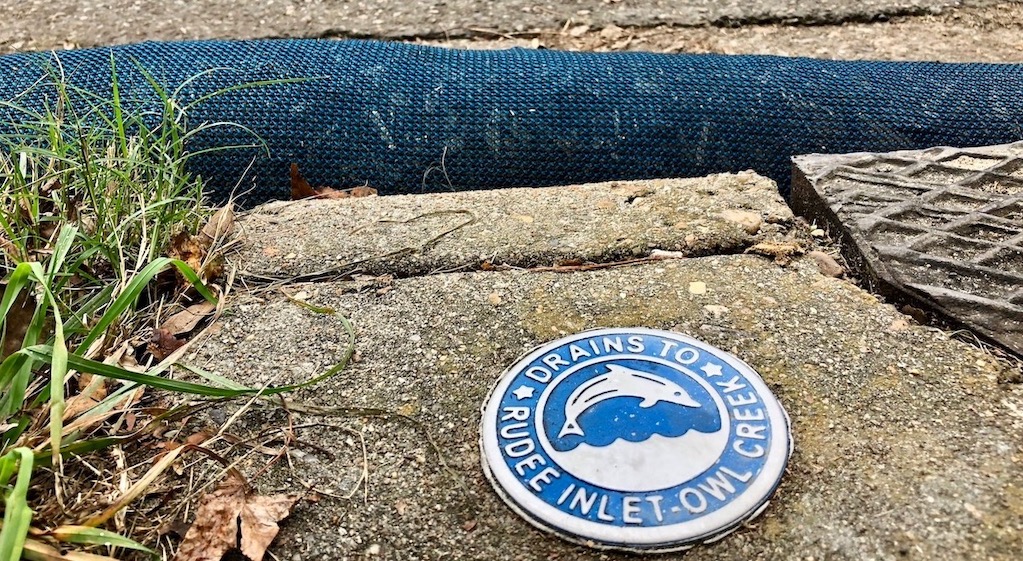
Compost Filter Silt Sock can be used for curb inlet and drop inlet protection. When placed in front of a grate or inlet, filter sock filters sediment laden runoff before it enters the stormwater system. It also prevents leaves, sticks and other debris from polluting the storm system.
You can use 10-foot wattle or custom cut a continuous pallet to the specified length.
For drop inlet protection, wrap the filter sock around the inlet and weight it in place with a sand bag or block.
If you are using Compost Filter Silt Sock for curb inlet protection, make sure you account for an extra foot on both sides of the inlet’s throat.
For example, if your curb inlet is 8 foot in length, the 10-foot Compost Filter Silt Sock wattle will be a perfect fit because you will have an extra foot for overlap on both sides of the opening.
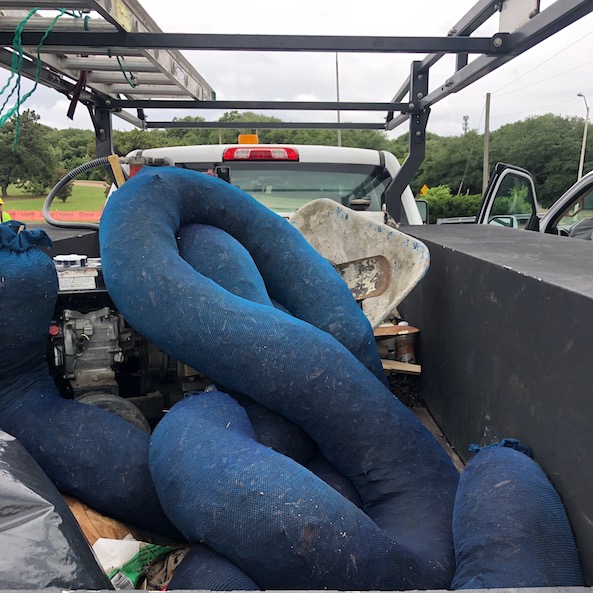
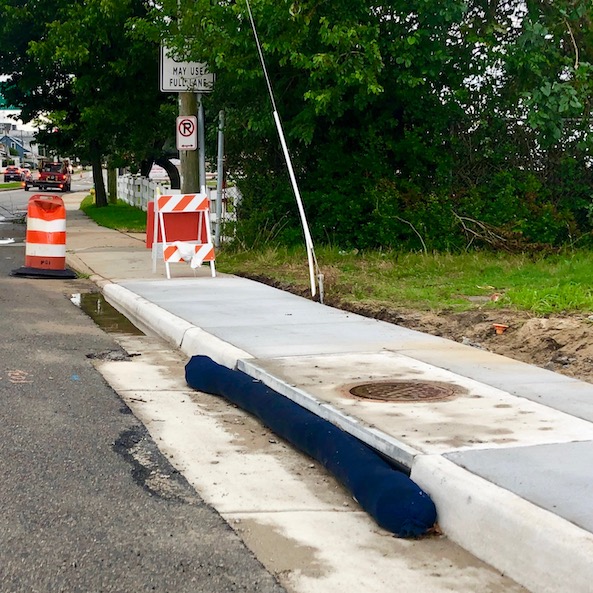
The decision between continuous pallet or pre-cut wattles ultimately comes down to cost analysis (how many inlets need protection and are the openings standard or variable) and personal preference.
The pictured intersection improvement project, for example, had a number of inlets that required protection during road reconstruction. The contractor purchased several pallets of 8″ x 200′ Compost Filter Silt Sock that they custom cut to fit the inlets. The on-site contractor drove from inlet to inlet with a continuous pallet of Compost Filter Silt Sock in the bed of his utility pickup. At each inlet, they measured the opening, cut the erosion control wattle and tied the ends with zip ties.
Check Dam

Check Dams are needed in swales, ditches or waterways that are subject to erosion.
A check dam is an erosion control device that traps sediment and reduces the velocity of water flow in a swale. There are a number of products that can be used as a check dam including rocks, Gabion Baskets, Coir Logs, Triangular Silt Dikes, Straw Wattles and Compost Filter Silt Sock.
We like the Compost Filter SiltSock for check dams for two reasons.
First: the continuous pallet sizing allows contractors to cut the exact size they need for each individual application site.
Second: Compost Filter Silt Sock is easy to remove. When the project is complete, you can cut open the erosion control wattle, remove the sock and leave the mulch in place.
Compost Filter Silt Sock should be installed on the downslope side. Drive wood stakes through the wattle to secure it in place. The size and height of the check dam will be determined by the site conditions. Most check dams will at least require a product that is at least 12″ in diameter.
Slope Interrupter
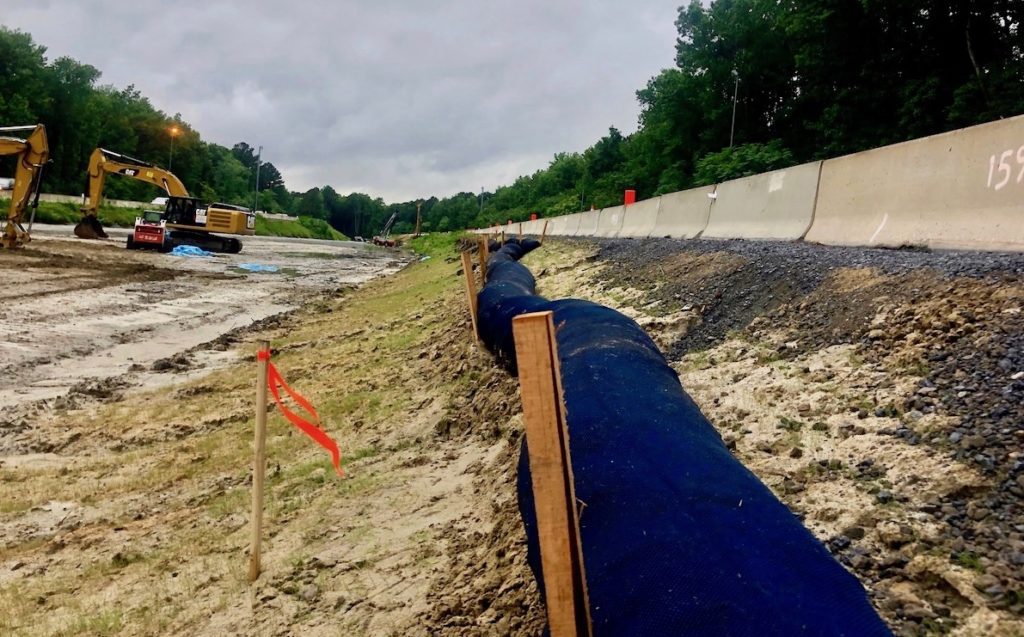
The last application we want to review is slope interruption. This application is not as common as the others but it is frequently seen on highway expansions and road reconstruction projects.
A slope interrupter is installed laterally across the slope following the contour of the grade. It should be staked in with posts at intervals that vary based on the product height and slope grade.
When water flows down the slope the slope interrupter diminishes the velocity of sheet flow and traps sediment. This prevents rills and gullies from eroding the slope.
Compost Filter Silt Sock, Excelsior Logs and Straw Wattles are all slope interrupters. The biggest difference between Compost Filter Silt Sock and the other erosion control logs is the weight. Filter Sock is a dense product that weighs up to 2000 pounds. This weight gives it better contact against the soil so it can withstand significant flow. The density of the product, however, can also make it difficult to install on a large or steep slope.
For that reason, Compost Filter Silt Sock is best suited for slope interruption on moderate slopes that are easily accessible.
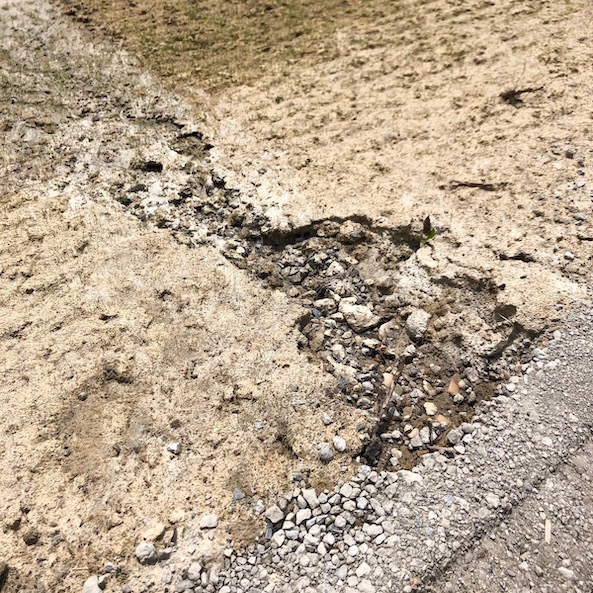
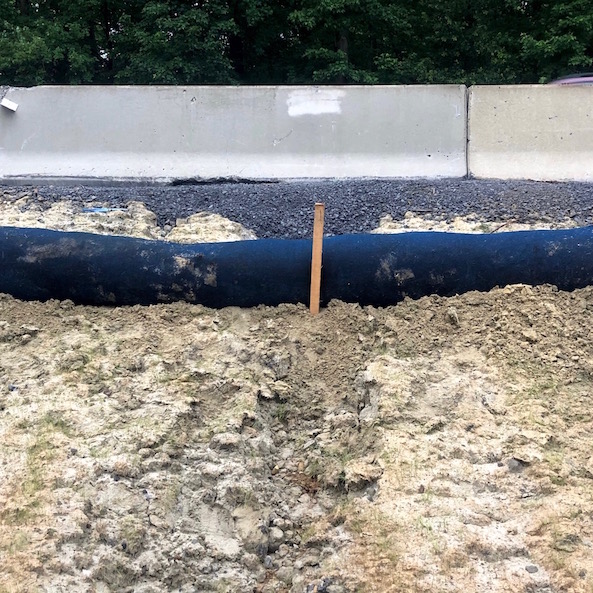
On the High Rise Bridge project in Chesapeake, Virginia, Compost Filter Silt Sock was installed for slope interruption on a moderate slope parallel to the interstate.
The on-site contractor found that rills were forming after major rain events. Runoff travelled from the road, down the slope into the median. These erosive cracks threatened the stability of the recently disturbed slope. In order to prevent the erosion from worsening, a continuous run of filter sock was installed along the top of the slope near the edge of the pavement. During subsequent rain events, the slope interrupter trapped the runoff and prevented it from flowing downslope.
Bonus: Compost Filter Silt Sock is an Affordable Solution
Not only does Compost Filter Silt Sock address four major sediment control applications, but it is also one of our most affordable erosion control wattles.
Cost Comparison
When we compared Compost Filter Sock to other Inlet Protection Devices, we found it was one of the most affordable inlet products for curb and drop inlet protection.
Curb Inlet Protection Products
| Compost Filter Sock | Excelsior Log | Dandy Curb | Travel Lane Wattle | |
|---|---|---|---|---|
| Product Size | 12″ x 10′ | 12″ x 10′ | 10′ | 8″ x 10′ |
| Cost Range | $ | $ | $$ | $$$ |
It is also one of our most affordable products in the wattle and log category.
Erosion Control Wattles and Logs
| Compost Filter Sock | Excelsior Log | Coir Log | Travel Lane Wattle | |
|---|---|---|---|---|
| Product Size | 12″ x 10′ | 12″ x 10′ | 12″ x 10′ | 8″ x 10′ |
| Cost Range | $ | $ | $$ | $$$ |
Want to learn more?
If you think Compost Filter Silt Sock might work well on your next project, give us a call. Our team can take a look at your project plans, read specifications, provide pricing and make recommendations for the product that will work best for you.
Read More About Compost Filter Silt Sock
How to Prepare Your Site for Hurricane Season
The Atlantic Hurricane Season starts on June 1 and ends on November 30. Each year…
Erosion Control for Residential Construction
Erosion control can be challenging on any construction site. Mitigating erosion and managing runoff on…



